| |
 |
Contributions and additions to the study of timbre "POSTAGE EXEMPT 1913 Order No 23466-913" |
 |
|
 |
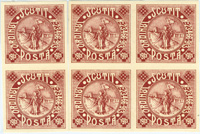
Figure 1 |
Because recently we celebrated one hundred years of the issuance of this stamp and to clarify some information regarding the occurrence and his circulation,

Figure 2 |
including counterfeits that all offered for sale through the Internet, I decided to write this article. For better information and clarification, I collected and collated information about them, discovered both in magazines and in the online media and describe in the lines below, along with some illustrations that I consider significant.
The postal administration of Romania, in the period between 1913 - 1932, has made, quite often, to the use of special stamps, for cultural or charitable organizations. Thus in early 1913 with the Order No. 23466-913, official correspondence of cultural society «Committee medal "OUR RIGHT"- Mircea and Charles the Great», was exempt from postal fees between April 17, 1913 and December 1929 [5]. An initiative committee founded the the society that had the first target celebration of Dobrogea with Romania reunion, Silistra annexation, and minting of commemorative medals, organizing fundraising for this purpose by public subscription [1]. The company was based in Iasi, and a subsidiary in Bucharest. Shortly after its establishment, a stamp was printed for the benefit of the company, possibly at the suggestion and initiative of a prominent member of the committee, C. Alessandrescu, secondary director and thereafter director of the Official Monitor in 1916 [8].
After the First Balkan War and after failure of the Romanian-Bulgarian negotiations in London on May 30, 1913, the Kingdom of Romania used the favorable situation during the Second Balkan War and annexed the South Dobrogea, which included the city Silistra, through the Bucharest Peace Treaty of July 18, 1913 [9]. Because the postage stamp reproduces in the medallion, the reverse of the commemorative medal, stamp was called "Silistra 1913", and the name has been used and maintained in the last hundred years.
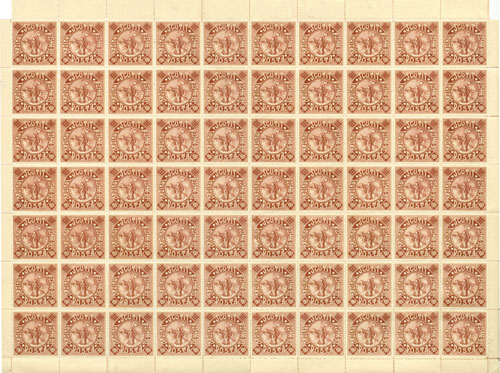
Figure 4 |
The stamp is colored reddish brown, size 36 ½ x 35 ½ mm, with the legend in double circle, and the center has a medallion with "Romania" represented allegorically by feminine character in armor bearing the national flag in his left hand and a sword in his right hand,
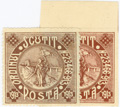
Figure 3 |
being distinguished in the background the Cernavoda bridge joining province of Dobrogea with Romania. Inside the medallion in the lower left are placed the words "VOEŞTE ŞI VEI PUTEA" (to want and you'll be able), and in the top right "DREPTUL NOSTRU" (Our Right). Around the central medallion was placed legend ORDINUL No. 23466-913 (order no....) and SCUTIT POSTA (postage extempt); In the upper corners were placed geometrical elements and the bottom corners year of issue "1913". Printing, through typographic process, was executed on Stamp Factory Bucharest [8], on the thin paper white, without watermak, line perforation 11 ½. Imperforated stamps without gum are known (Figure 1) which may come from a final sheet without gum and perforations. Some specimens have been reported having olive-gray color (Figure 2, signed "Nathanson"), considered essays [3] [10], but they may come from unused stamps, long exposed to sunlight.

Figure 16 |
I have not tested this hypothesis because summer is over. The only color variety that deserves mention is a shade of brown pronounced (Figure 3), but which I can not say too much because it is the only specimen discovered. In the last year appeared much sought, the sheets, three in number, one in a private collection and two in my collection. On this occasion, it may be revised the number of stamps in the finished sheet, which is 70 stamps, not 100 stamps, as it was mentioned before in most catalogs [3]. It is interesting that one of the sheets I possess, has vertically watermark X, located in the first column on the left side of the sheet (Figure 4). Sheets have on all edges colored lines to guide combs for lacing machine. In the future, I will publish a study of these stamps and their distribution in the sheet.
Georges Brunel in publication, Les timbres du Royaume de Roumanie, Paris, 1913, signaled the emergence of this stamp, makes an extensive history and the way of applying the exemption of postage on the official correspondence of committee. Between April 17 and July 5, 1913 were used envelopes with printed header

Figure 17 |
«Comitetul medaliei "Dreptul Nostru" Mircea şi Carol cel Mare» (Committee medal "our righ" Mircea and Charles the Great), which bear a stamp with purple ink, with text in the three-row, "SCUTITE Ordinul telegrafic No.23466 din 17-4-1913" (EXEMPT order telegraph No.23466 of 17-4-1913), without applying any postage stamp. Further, the author suggests that a member of the Committee as possible philatelist, launched the idea of printing a postage stamp to replace the text stamp and include the design reverse of the medal that would be issued (Figure 16 and Figure 17). Furthermore mentions a possible circulation of 50,000 copies, information taken from Illustrator. Briefmarken Zeitung, but not confirmed until now [1]. I will reproduce a few passages from this article:
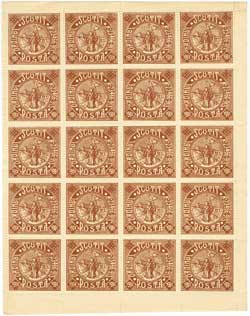
Figure 7 |
TIMBRES DE FRANCHISE 1913
Comme suite a la seconde guerre Balkanique, la Roumanie, a la suite de longs pourparlers avec la Bulgarie, a pu s'annexer la Dobrouska, qu'elle convoitat depuis longtemps; cette annexion, amenée sans effusion de sang, a causé chez tous les Roumanins un grand enthousiasme.Pour commémorer cet événement, une société patriotique eut l'idée de faire frapper une médaille commémorative..........
Devant le succes que rencontra cette médaille, la société demanda a l'administration des postes, la franchise postale pour l'expédition aux souscripteurs. L'administration accorda la franchise par décret du 17 avril 1913.
Il était donc utile de reconnaître la franchise........(author's note. here are described letterhead envelope, seal and stamp committee for free)
Du 17 avril au 5 juillet 1913, les envois de prospectus s'effectuaient dans les conditions indiquées ci-dessus, mais alors un membre de la Société, qui était philatéliste, suggéra a l'administration l'idée d'un timbre special.....
Les premieres vignettes furent vendues cinq francs piece (d'apres l;information que nous relevons dans l'Illustr. Brief. Zeit) le tirage fut de 50.000 vignettes....
Regarding real number of copies, has not yet found any document to clarify this information.
The first signals of fakes and their characteristics description was done by G. Nosca, in an article published in Romanian Philatelic Society no. 12/decembrie 1939 [2]. Information was repeated with additions and describing of the basic elements in the recognition of fakes and republished in "Romanian Philatelic Studies" in 1979 [4]. From then until now, the study has not been developed, most catalogs indicating the existence of forgeries, without extensive detail.
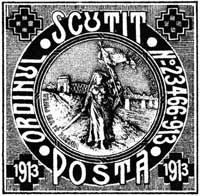
Figure 5 - GENUINE |
Much later, two articles published last year online on private blogs, reminds about the fakes issue, but does not discuss about them specifically.
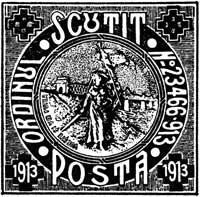
Figure 6 - FORGERY |
In this article I will try to reproduce and to point out important areas that distinguish the fake from the original, although a larger image sufficiently speaks for itself (Figure 5 and Figure 6).
Forgeries (Figure 6) were performed in sheet of 20 clichés (Figure 7) through lithographic process on thicker paper and more porous than the original, with irregular perforation and on the sheet edges are totally missing the guidelines for perforation. Gum of counterfeits is different from the originals. The outer frame is thicker than the original (Figure 5), with dimensions of 36 × 35 mm, the background drawing is grossly hatchlings that form the background of the frame are irregular, thicker heads, and there interrupted and unevenly spaced from the frame and circle. Originally, hatchlings are uniform, equal and equally spaced along the length of the frame and circle. Inside the two upper trim, hatching style at the original are three vertical and regular rows, at the fakes are deformed, irregular and only two rows. The original central medallion sky consists of very fine horizontal lines, parallel dashed from place to place, and at the fakes are made of dots and spots like worms. The original coat of arms on the flag is pretty well defined, at forgery can see some spots that does not resemble with the original. The hand that holds the flag is seen distinct from the original, including shaded shadow, at forgery is a simple white patch that continues to the tail flag.
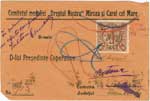
Figure 8 |
At the original sword has a center line that is missing at fakes. The whole design of the original details "Romania" has very distinct and visible when at forgery are in the form of spots that do not permit the details distinction. Bridgehead and the bridge itself looks original construction details, which can be distinguished even with the naked eye, while at forgery are replaced by spots that miss any details. Generally forgeries are more shaded than the original, presenting lithography features that are missing at typography stamps.

Figure 9 |
About correspondence stamped with these stamps it was specified that are rare due to the short period of use, between October and December 1913, information which has been taken by most catalogs [3]. But after recent research, the range in which these stamps were used can be increased. As you can see in the pictures, the earliest circulation discovered so far is July 28, 1913 (Figure 9), sent locally in Iasi, and the latter is January 14, 1914 (Figure 10), sent by Iasi to Bucharest, the "Administration Medal our right.". Are known a small number of postal envelopes used. In my personal collection have 57 envelopes (in a state of preservation, not too good), and I found a few pieces online and to the stamps auction houses. Most of them are returns, to the initiative committee. There are known various annotations made by postmen, on the envelopes, for example "RETURN", "addressee unknown", "address indicated is wrong",
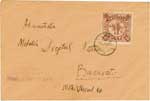
Figure 10 |
"unknown to the appeal of factors", "cooperative is not at that address". Also known envelopes bearing labels with various Mail indications from other countries, applied to the destination: "UNBEKANNT", or stamp "SCONOSCIUTO AL PORTALETTERE" or "ZURUCKausgeh". Almost all often have only made the recipient's name and location without street and number. An explanation of these wrong addresses, and returns could be that the address register has been kept in a flooded basement, and after a disaster addresses became irretrievable. Information is plausible, but not confirmed. Not wanting to keep occupied the magazine space with pictures of all variants of return, which are already presented in an One frame exhibit at the World Stamp Exhibition INDIPEX 2011 and awarded with a Vermeil medal rank.

Figure 11 |
Normally used envelopes should have header (Figure 8), as were those used by the appearance of stamps printed, but in their absence were used envelopes without letterhead, but affix a stamp bearing the header purpose. Shipped from the central office in Iasi bears a stamp in the lower left hand by the linear arranged in three rows, «COMITETUL MEDALIEI "DREPTUL NOSTRU" Mircea şi Carol cel Mare» (Figure 11), and the correspondence sent from Bucharest to apply a stamp with a similar text, plus an added row which was inscribed the city name, "BUCUREŞTI" (Figure 12).
I found a few letterhead envelopes sent to both offices in August and September 1913, but most other envelopes is simple, bearing stamps Committee replacing the header. If you encounter envelopes sent from other places than Iasi and Bucharest, you have to be careful, he has no justification to use and is likely to be counterfeit.

Fifure 12 |
It is possible that after this article appear more relevant information. That is not its purpose ?

Figure 13 |
If you find envelopes sent from other places than Iasi and Bucharest, you have to exercise caution, he has no justification and is might be falsified. It is possible that after this article appears, and other relevant information. One purpose of this is. No?
What can I add, is that this issue stamps, has not escaped the speculators philatelic inventiveness that outside of falsifying stamps, taking advantage of lack of concrete information about their use, have used various forms of deception. Some forgery stamps were canceled with backdated day pmk. (Figure 13, BUCURESTI RECOMANDATE 3 FEB 913), or invented pmk. (Figure 14, BUCURESCI day/month).

Figure 14 |
It was up to the production of "rare" philatelic material, original stamps block of four or larger parties, glued on the envelope fragments, and genuine pmk. canceled (Figure 15). These stamps were issued solely for correspondence from initiative committee the medal Our Right. They, having no generally franking power, do not justify the appearance of blocks of four or larger formations on the Mail. Absolutely all envelopes committee, especially letterhead, have only one "Silistra 1913 postage exempt" applied just over stamp SCUTITE Ordinul telegrafic No.23466 din 17-4-1913 (EXEMPT telegraphic order No 23466 from 17-4-1913).
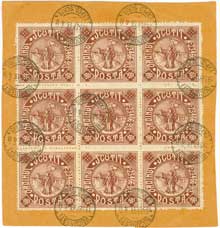
Figure 15 |
I hope this article reopen interest in this issue, and to be able to fill any information gaps.
Bibliograpy:
[1]-"Les Timbres des Royaume de Roumanie", Georges Brunel, Paris 1913;
[2]-"Romanian Philatelic Society Magazine", no. 12 December 1939 -"Romanian postage stamps forgery" G.Nosca (in Romanian);
[3]-"Catalogue of Romanian postage stamps" - CMPR 1974, CMPR 1984;
[4]-"Romanian Philatelic Studies" vol. 3, no. 3, 1979
[5]-"Prices, fees and exemptions in Romania post 1841-2008" vol. 1, Ing. Călin Marinescu (in Romanian);
[6]- Stanley Gibbons Stamp catalogue part 3, Balkans 5th edition;
[7]- Michel Rümanien catalogue 2013;
[8]- "Official Monitory 100 years, 1832-1932" (in Romanian);
[9]- http://en.wikipedia.org/wiki/Second_Balkan_War;
[10]- http://www.romaniastamps.com/essays/ (...and more);
[11]-http://www.romaniastamps.com/forg/forgeframe.htm (Silistra II);
[12]- http://romanianstampnews.blogspot.ro/2012/10/marca-scutit-din-1913.html
Figures 16 and 17 are from a private collection, courtesy of the owner.
Francisc Ambruş, October 2013
|
 |
|
|

